Trump Favorability
President Donald Trump’s favorability continues to trend downward. Less than four in ten (38%) Americans hold favorable views of Trump and nearly six in ten (59%) view him unfavorably. Trump’s current favorability is not significantly different from May (41% favorable, 55% unfavorable) or April (42% favorable, 54% unfavorable), but it is substantially down from his high point in March (49% favorable, 46% unfavorable). The current numbers are slightly lower than his 2019 average (41% favorable, 55% unfavorable), but again, the difference is not statistically significant.
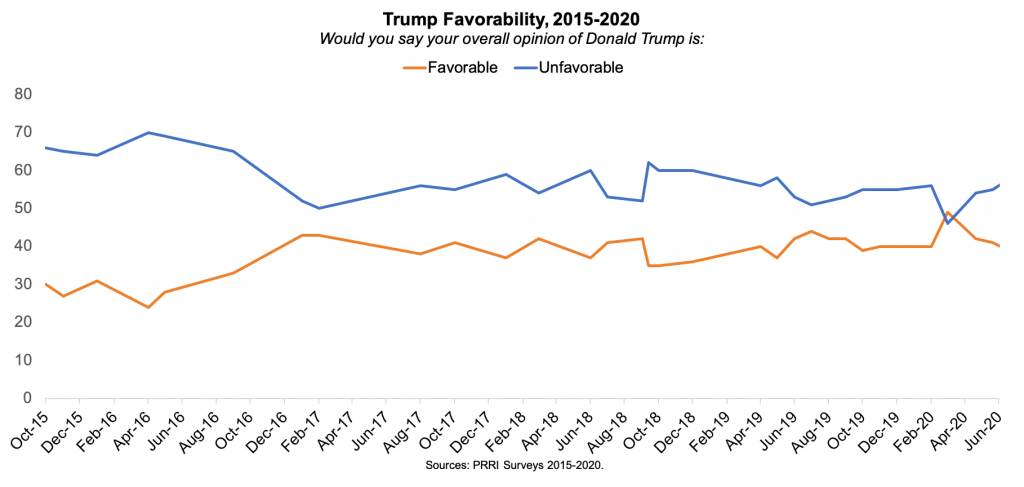
Favorable views of Trump remain essentially unchanged across many demographic groups since May 2020. Some groups, however, have become notably less likely to view Trump favorably than they did throughout 2019. For example, Trump’s favorability has dipped significantly among women (from 35% to 30%) and Americans living in battleground states (from 43% to 35%). Notably, favorability of Trump has dropped significantly among white Americans overall (from 49% to 43%) and among a number of important white subgroups, including white women (from 42% to 35%), white Christians overall (from 54% to 47%), white Catholics (from 49% to 36%), and white Americans with a four-year college degree (42% to 29%).
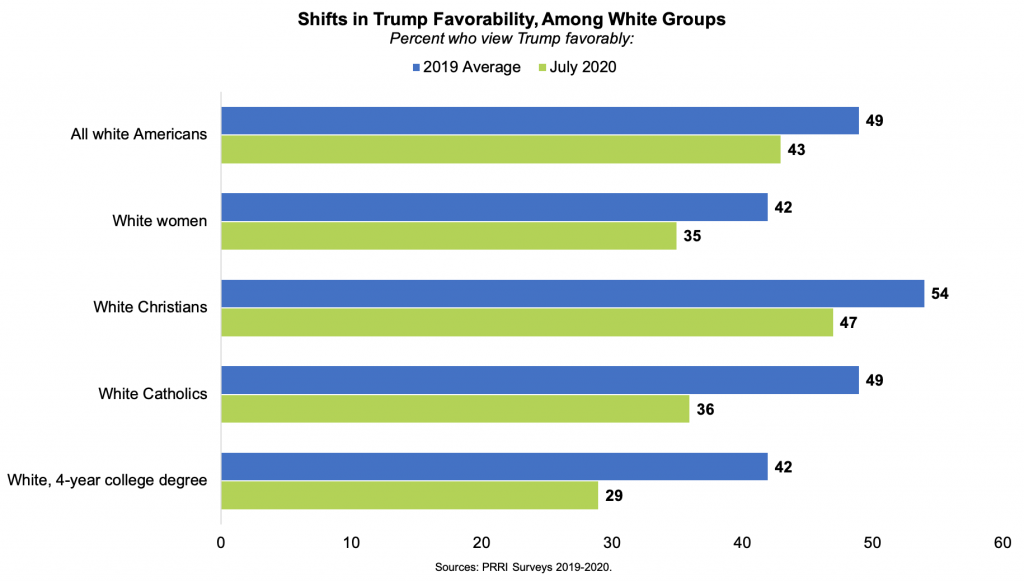
Party Affiliation
More than eight in ten (84%) Republicans hold favorable views of Trump, similar to 83% in May, and down from 90% in April and 89% in March. However, Republicans are more likely to report favorable views of the president now than throughout 2019 (79%). Among independents, 36% hold a favorable view of Trump, unchanged from May (35%) or their 2019 average (37%), but down from 43% in April and 45% in March. Democrats have shown significant movement since May. The proportion viewing Trump favorably has declined by half in July (7%), compared to May (14%), and is also around half of the president’s 2019 average favorability among Democrats (15%). This is near Trump’s previous low among Democrats in September 2018 (6%).
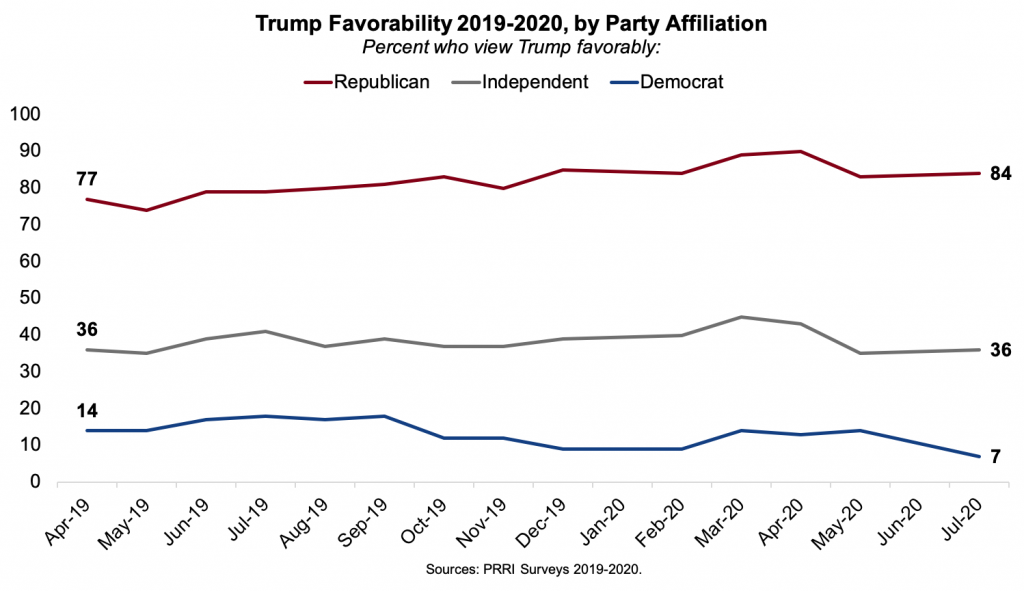
Religious Affiliation
More than six in ten (63%) white evangelical Protestants, about four in ten (41%) white mainline Protestants, 36% of white Catholics, 32% of nonwhite Protestants, and 26% of religiously unaffiliated Americans hold favorable views of Trump.[1] Favorable views of Trump among white mainline Protestants have declined by 10 percentage points since May (51% to 41%), and by eight points among both nonwhite Protestants (from 40% in May to 32%) and religiously unaffiliated Americans (from 34% in May to 26%), but due to the small sample size these differences are not statistically significant. White evangelical Protestants and white Catholics have held steady since May (62% and 37%, respectively). Among religious groups, only white Catholics register favorable views of Trump that are significantly below their 2019 average (49%).
Among all white Christians, less than half (47%) hold favorable views of Trump, compared to a slim majority (52%) in May, although the difference is not statistically significant. However, the percentage of white Christians viewing the president favorably has declined significantly from their 2019 average (54%). That change is mostly driven by white Catholics and a modest, but not significant, decline among white mainline Protestants (48% throughout 2019 to 41%). Notably, there are stark differences between the views of white Christian subgroups and white religiously unaffiliated Americans, among whom only 29% hold a favorable view of Trump.
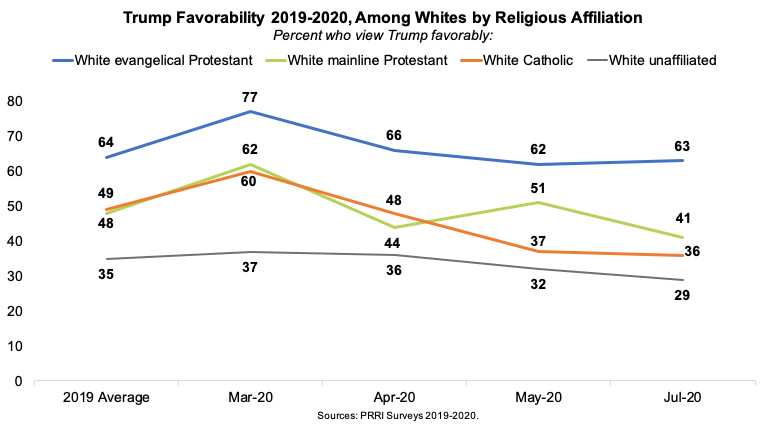
Race and Ethnicity, Gender, and Education
More than four in ten (43%) white Americans hold favorable views of Trump, compared to just over one-third (35%) of Hispanic Americans and less than one in five (19%) Black Americans. While Hispanic and Black Americans have not significantly changed their views compared to 2019 averages (28% and 18%, respectively), white Americans have become notably less likely to hold favorable views of Trump (43% today vs. 49% in 2019).
A wide gender gap persists today as it did in May, with men much more likely than women to hold favorable views of Trump (47% vs. 30%). Women are significantly less likely to hold favorable views today (30%) than they did throughout 2019 (35%), but men are unchanged (47% throughout 2019). This trend also appears among white men and white women. A slim majority of white men (51%) report favorable views of Trump, similar to 53% in May and 55% in 2019. By contrast, just over one-third (35%) of white women hold favorable views of Trump, a significantly lower proportion than their 2019 average (42%).
Among white Americans without a four-year college degree, views of Trump have not substantially changed since May or from 2019 levels (51% today vs. 47% in May and 52% in 2019). By contrast, among white Americans with a four-year college degree, favorable views of the president have declined by more than 15 percentage points from May (29% today vs. 45% in May) and are also significantly lower than throughout 2019 (42%).
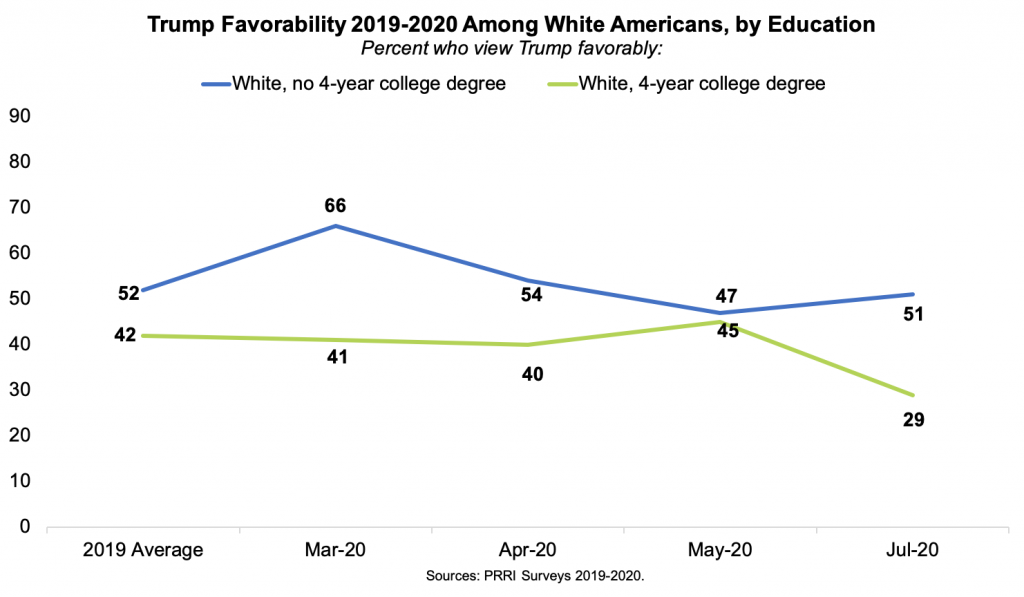
Age
Trump continues to have worse ratings among younger Americans than older Americans, with a notable break around age 50. Among those ages 18-29, only 35% view the president favorably, and in the 30-49 age group, only 31% view Trump favorably. His numbers improve a bit among those ages 50-64 (42% favorable), and among those 65 and over (47% favorable).
Compared to late May, there are no significant changes across age groups with the exception of Americans ages 30 to 49. This group is significantly less likely to hold favorable views of Trump than in late May (41%) and throughout 2019 (39%). All other age groups remain virtually unchanged, compared to late May as well as 2019 averages.
2016 Battleground States
Among Americans living in 2016 battleground states, attitudes toward Trump show a downward trend since May.[2] About one-third (35%) of Americans who live in battleground states report favorable views of Trump, a 15 percentage point drop since May (50%). These favorable views are also down from 2019 levels (43%). More than four in ten (44%) Americans who live in Republican or Republican leaning states hold favorable views of the president, as do 34% of those who live in Democratic or Democratic leaning states. Among Americans who live in Republican or Republican leaning states and Democrat or Democrat leaning states, these views have remained virtually unchanged since May (45% and 35%, respectively) and from 2019 levels (46% and 35%, respectively).
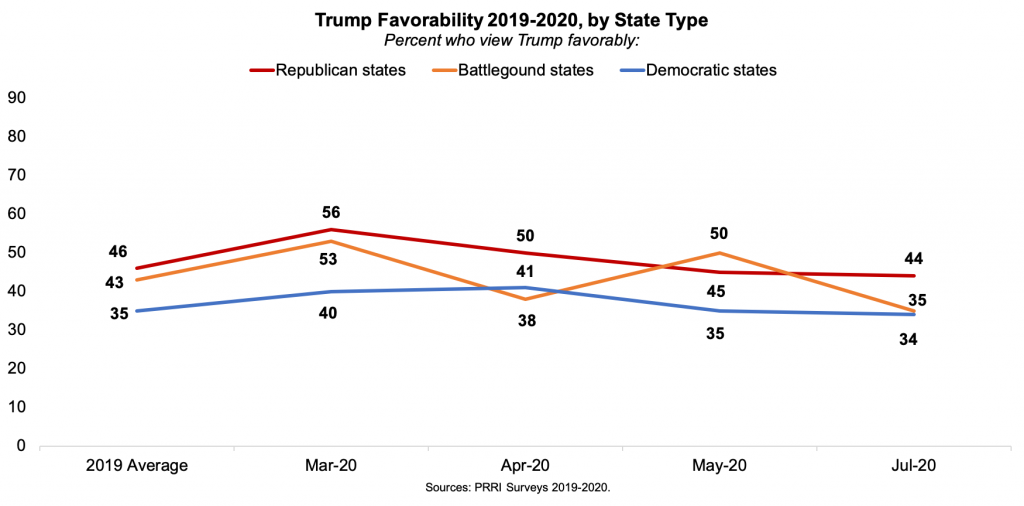
Biden Favorability
Americans are generally more positive toward the former vice president and presumptive Democratic presidential nominee Joe Biden, but they remain divided, with 48% holding a favorable view and 45% holding an unfavorable view of Trump’s competitor. This is unchanged since PRRI last asked the question in September 2019, when 48% viewed Biden favorably and 45% unfavorably.
Party Affiliation
Unsurprisingly, Democrats (81%) are much more likely than Republicans (13%) to hold favorable views of Biden. Independents divide, with 43% expressing favorable views and 47% unfavorable. Democrats (74%) were slightly less favorable and Republicans (19%) were slightly more favorable toward Biden in 2019. Independents have not substantially changed their views since 2019 when 46% viewed Biden favorably and 45% unfavorably.
Democrats who identify as liberal are more likely than those who identify as moderate or conservative to hold favorable views of Biden (87% vs. 76%, respectively). Liberal Democrats have become significantly more favorable toward the former vice president since 2019 (77%), but moderate and conservative Democrats have held steady since 2019 (72%).
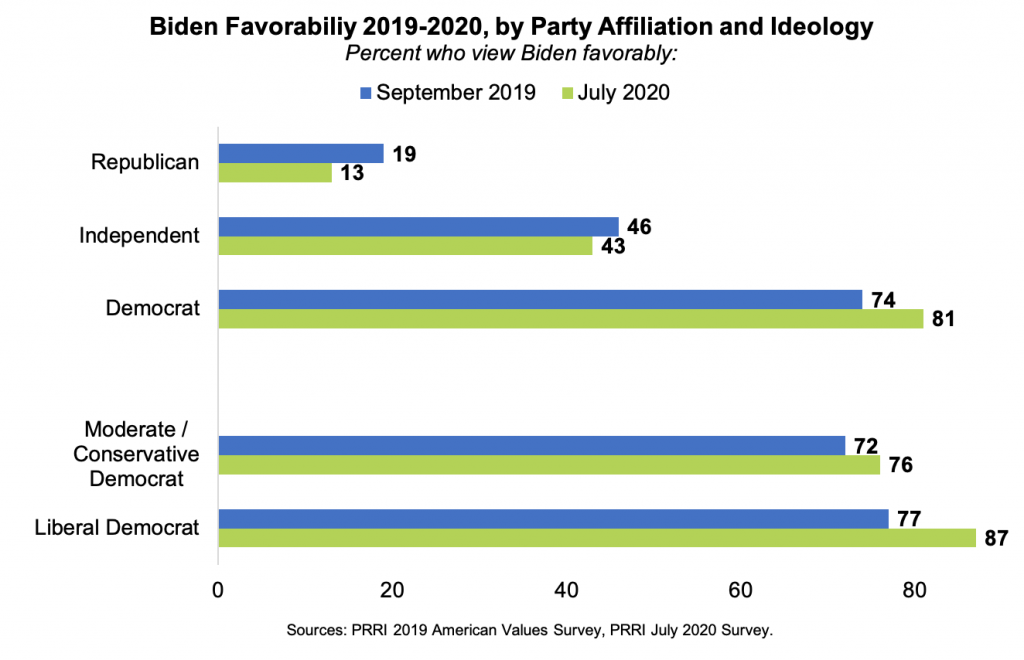
Religious Affiliation
Religiously unaffiliated Americans (57%) and nonwhite Protestants (57%) are more likely to express favorable views of Biden than white Christian groups (39%). Less than half of white mainline Protestants (49%), white Catholics (40%), and white evangelical Protestants (29%) view the former vice president favorably. No religious group has significantly changed their views of Biden since 2019.
Race, Gender, and Education
Black Americans (71%) are much more likely than Hispanic (46%) and white (44%) Americans to hold favorable views of Biden. Hispanic Americans have become less likely to hold favorable views of Biden than in 2019 (55%), but the difference is not statistically significant. Black and white Americans have held steady since 2019 (68% and 43%, respectively).
There are substantial gaps by gender and education among white Americans. Among all Americans, 53% of women and 42% of men hold favorable views of the former vice president. The gap widens among white Americans. A slim majority (52%) of white women, compared to only 36% of white men, hold favorable views of Biden. There was no significant gender gap between white women and white men in 2019 (44% vs. 42%, respectively).
Six in ten (60%) of all Americans with a four-year college degree, and 42% of those without a four-year degree, hold favorable views of Biden. The education gap is wider among white Americans. White Americans with a four-year college degree (60%) are 25 percentage points more likely than white Americans without a four-year college degree (35%) to report favorable views of Biden. Whites with college degrees are significantly more likely to view Biden favorably than in 2019 (52%), while those without college degrees have remained mostly unchanged (38%).
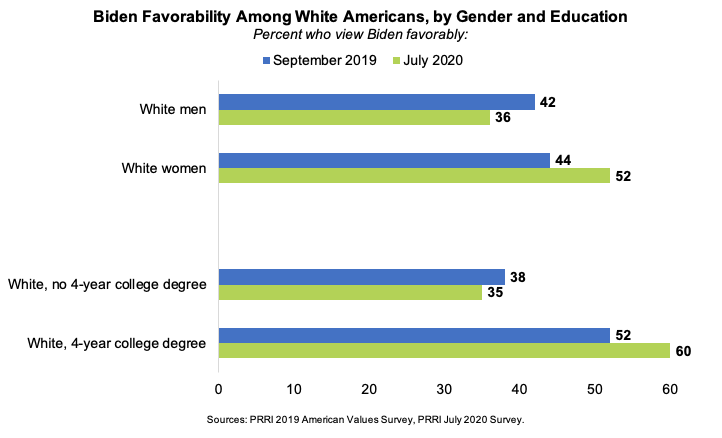
Age
Biden fares slightly better with older Americans than younger age groups, although none of the differences are statistically significant. About four in ten (42%) of those ages 18-29, compared to approximately half of those ages 30-49 (50%), 50-64 (50%), and 65 and over (47%), view the former vice president favorably. These numbers have not significantly changed since 2019 for any age group.
2016 Battleground States
There are no statistically significant differences in Biden’s favorability by party lean or battleground status of the states. In the states that were hotly contested battlegrounds in 2016, almost half (49%) of residents hold favorable views of Biden. That ticks up to half (50%) holding favorable views of the former vice president in Democratic and Democratic-leaning states. In Republican and Republican-leaning states, 44% view Biden favorably. These numbers do not shift if only current 2020 battlegrounds (Arizona, Georgia, North Carolina, and Florida) are used.
Electoral Implications
With less than four months until the November election, Biden appears well situated in comparison to Trump. Among key white subgroups that anchored Trump’s win in 2016, Trump is viewed more favorably than Biden, including among white men (51% compared to 36%), white Americans without four-year college degrees (51% compared to 35%), and white evangelical Protestants (63% compared to 29%).
However, Biden is viewed more favorably by white women (52% compared to Trump’s 35%), white Americans with four-year college degrees (60% compared to 29%), and white religiously unaffiliated Americans (60% compared to 29%). Additionally, Biden is viewed slightly, although more favorably than Trump among white mainline Protestants (49% compared to 41%), and white Catholics (40% compared to 36%), although these differences are not statistically significant.
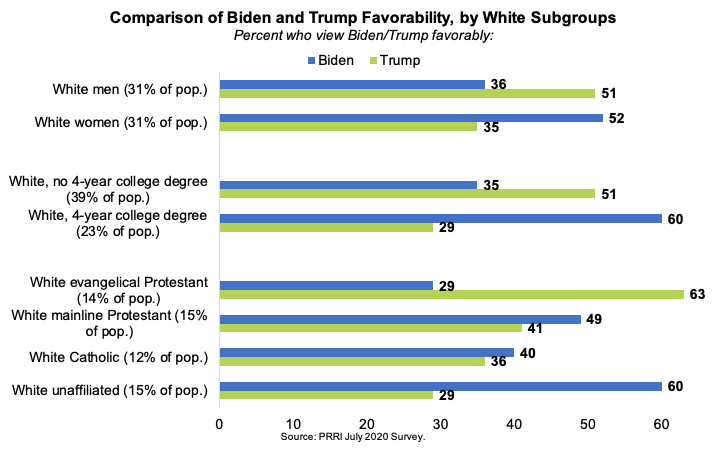
Registered Voters, Independents, and Moderates
Among registered voters, Biden (49%) holds a significant favorability advantage over Trump (38%), essentially the same as among all Americans (48% and 38% respectively). Among registered voters, more than four in ten (45%) Americans hold favorable views of only Biden, while 33% hold favorable views of only Trump. Almost no registered voters (3%) hold favorable views of both candidates, while 14% hold unfavorable views of both Trump and Biden.
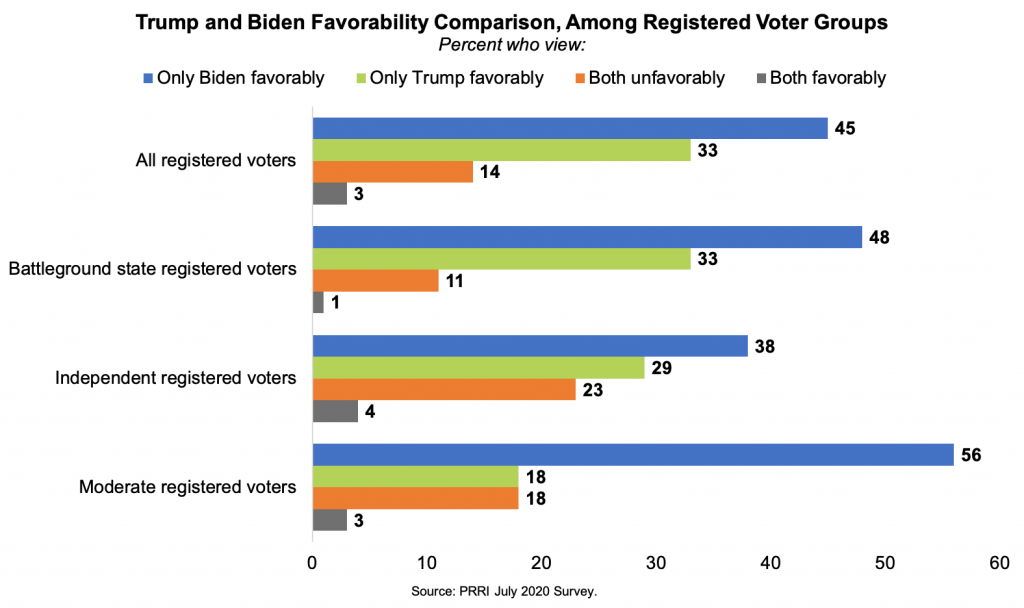
Biden also appears well-positioned among voters in the battleground states. Just under half (48%) of registered voters in the battleground states say they have favorable views of only Biden, while 33% say they have favorable views of only Trump. Registered voters in battleground states (48%) and Democratic states (47%) appear marginally more likely than registered voters in Republican states (41%) to have favorable views of only Biden, but the difference is not statistically significant.
Biden also holds an advantage among independent and moderate registered voters. Around four in ten (38%) independent registered voters hold favorable views of Biden only, compared to 29% who hold favorable views of Trump only. Notably, nearly one in four (23%) independent registered voters hold unfavorable views of both candidates. Among moderate registered voters, Biden holds an even wider favorability margin, with a majority (56%) who hold favorable views of only him, while fewer than two in ten (18%) hold favorable views of only Trump.
Methodology and Footnotes
The survey was designed and conducted by PRRI. Results of the survey are based on bilingual (Spanish and English) RDD telephone interviews conducted between July 7 and July 12, 2020, by professional interviewers under the direction of SSRS. Interviews were conducted among a random sample of 1,000 adults 18 years of age or older living in the United States (701 respondents were interviewed on a cell phone). The margin of error for the survey is +/- 3.5 percentage points at the 95% level of confidence, which includes the design effect for the survey of 1.3.
Footnotes
[1] Sample size for Black Protestants, Hispanic Protestants, Hispanic Catholics, and non-Christian religions are too small to report individually. Protestant Christians who identify as Black, Hispanic, Asian or Pacific Islander, Native American, multiracial, or any other race are included in nonwhite Protestants.
[2] Battleground states are Arizona, Florida, Michigan, North Carolina, Pennsylvania, and Wisconsin. These states are listed in the “Toss-up” category by Cook Political Report, as of March 9th. These were the six closest races in 2016. The Cook battlegrounds were updated to only include Arizona, Georgia, Florida, and North Carolina in July, with Michigan, Pennsylvania, and Wisconsin moving to the “lean Democrat” column. Making these changes does not change the numbers above in statistically significant ways, therefore we have kept the original 6 battlegrounds as the closest 2016 states.





